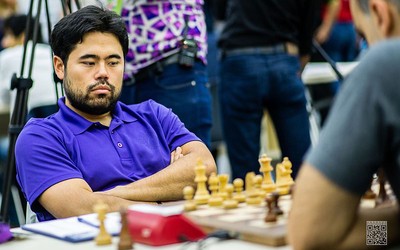
By photographer: Mankasculptor: Vladimír Oppl (2003) - Self-photographed, CC BY 3.0, https://commons.wikimedia.org/w/index.php?curid=2682754
The World Champions' Weirdest Pets - Wilhelm Steinitz and the King's Gambit
This series of articles will cover some of the weirdest openings world champions have played consistently.Donations are much appreciated. All of my content and writings will be free forever according to the "Truthdoc code" (to be published some time next year) - help keep such content going strong :). Donate
Introduction
Steinitz, the first official world chess champion, is very much seen as the father of the classical school of chess. Therefore, Steinitz's games are mostly devoid of "weird openings." However, every chess player, no matter their strength, has their weird tastes, so the reader will be happy to know that there will be four articles covering Steinitz's weird opening adventures - one on the Steinitz Attack, the second on the Dutch Defense, the third on the Vienna Game, and the fourth on the King's Gambit. I must mention that "early Steinitz" was very much a swashbuckler, and the positional Steinitz only appeared in the second half of his career.
First of all, we must define what a "weird opening" is. There's no clear-cut definition, but to me, a weird opening is any opening that is: a) almost never played at top level (in the 21st century! - circa 2021) and b) breaks known opening principles and generally goes against the "classical" principles Steinitz himself had helped create / bring into focus. For example, the King's Gambit would be a normal opening in Steinitz's time, but it's definitely a "weird opening" in the 21st century as it's almost never played by any top player, and no top player plays it consistently. Let's see Romantic Steinitz at his finest!
The King's Gambit
Note: The variations covered will only deal with those that were played in the games featured in this article.
When one thinks of the Romantic era of sacrificial chess, one's mind is immediately drawn to one single opening: the King's Gambit! On just the second move, White breaks the symmetry imposed on the board and tries to sacrifice a pawn to get quick development and an open f-file for their rook. Nowadays, centuries of opening analysis and the advent of strong chess engines has made this opening a very rare guest at top level, but make no mistake - to this day, many top players have used the King's Gambit to great effect. Perhaps in correspondence chess the King's Gambit isn't sound, but, as GM John Shaw, the author of the definitive tome on the King's Gambit, says, "However, over the board it is clear that the King's Gambit is effective at all levels up to and including 2800+." Let's dive into the world of swashbuckling Romantic wonders!
A Crushing Victory
Camille Moriau was a French chess player who was active in the English chess scene in the late 1800's. He used to give blindfold simultaneous exhibitions on several boards, so he was certainly a strong player who could give Steinitz a tough match. Let's see how Steinitz fares against Moriau's defense to the King's Gambit.
Moriau declines Steinitz's King's Gambit, only to be met with aggression that has the King's Gambit Accepted's stamp of approval. Of course, the game wasn't perfect, but how many King's Gambit games are? 38. Kc1 was quite a picturesque finish as well.
A Devastating Defeat
Adolf Anderssen needs no introduction. He is well known to have fought toe-to-toe against Morphy and to have been the man behind the Immortal Game and the Evergreen Game. Therefore, burgeoning Steinitz was playing against a well-established chess legend!
Truly a devastating defeat! Steinitz got what he wanted out of the opening and created a whirlwind of an attack. However, Anderssen was able to weather the storm and not allow any path to clarity. The reward was mighty Steinitz's king!
A Slugfest
We've already introduced Gustav Neumann in the second part of this series, and we've already seen him play a slugfest of a game against Steinitz. History has a knack of repeating itself...
What an incomprehensible game! I hope I helped make it a bit more understandable, but I do understand if you're left feeling that chess is simply too deep a game - I bet the players felt the same.
A Hard-Fought Draw
Johannes Zukertort is another chess master who I believe is quite well-known, even to non–chess historians. He was a polymath and an exceedingly strong chess player who played Steintiz for the first ever official world championship match (where, obviously, he lost). Let's witness Romantic chess at its peak!
All in all, this game had quite a fair result. Both players' pieces were all over the place, so the petering out that occurred toward the end of the game made the most "poetic" sense. Definitely, though, White had a tougher task as his king was in more immediate danger, but both sides were winning at some point in the game, so, again, both sides shouldn't be that upset with a draw.
A Peaceful Game
Frederic Deacon was a British chess master who had some very reasonable results against very strong players, including Steinitz himself. Unfortunately, his reputation has been marred by his claims that he had drawn Morphy - Steinitz would later call him out on it and say that Deacon would ask players to play a certain line and beat them "in analysis." I encourage the reader to search for more Deacon lore on the various chess history websites. Anyway, back to the chess:
This is the most peaceful a game can get in the King's Gambit! There were some fireworks at the start, but, eventually, the players both seemed content to draw the game, and so they did.
Test
Refute White's opening inaccuracy!
Punish Black's greed.
Don't prolong the game!
No fancy play syndrome
LPDO
Steinitz was a poker player!
Play for the win!
Calculate ten moves deep...
Conclusion
Swashbuckling Steinitz is the Steinitz we like to see, but Steinitz wouldn't be Steinitz had he continued to play the King's Gambit at every twist and turn. What makes the first world champion so legendary is that he not only had won some spectacular games with hyperaggressive openings, but he also decided to create a new school of chess based on positional factors and long-term thinking. Huzzah to the two forms of Steinitz which make his single being complete!
More blog posts by FischyVishy

Attacking Chess Patterns: Grand Prix, Queen(1) Attack, and Grand Thorn
In this series of articles, I list and explain all kinds of chess patterns. Chess patterns are recur…
Why Bughouse Is Good for the Environment
Bughouse — Give it a try if you care about planet Earth.
Nakamura's Secret Weapon Against the Réti Opening - The Ideal Center (Part 2)
In this series of articles, we will deeply analyze a very interesting and novel setup that Hikaru Na…
